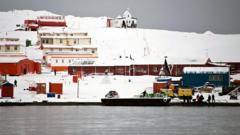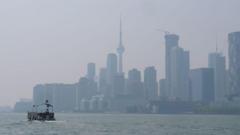While Ushuaia, Argentina experiences an influx of tourists visiting Antarctica, the surge in visitors brings financial prosperity but also strains local resources and affects the environment.
The Economic Boom of Ushuaia: Blessing or Burden?

The Economic Boom of Ushuaia: Blessing or Burden?
As Ushuaia thrives on Antarctic tourism, locals face rising living costs and environmental concerns.
In the southernmost city of the world, Ushuaia, Argentina, the summer of 2025 is witnessing an unprecedented wave of tourism as eager travelers flock to embark on voyages to Antarctica. Home to approximately 83,000 residents, Ushuaia has become a bustling hub for around 90 percent of Antarctic cruises, with cruise ships crowding its docks during peak months.
Last year, the number of Antarctic passengers departing from Ushuaia soared to 111,500—a significant leap from just over 35,500 a decade earlier. As the current season comes to a close, local port authorities anticipate an even higher influx of tourists, likely increasing the number by 10 percent. Many visitors extend their stay in Ushuaia, opting for Airbnb accommodations that surpass the limited offerings of local hotels.
While this economic boom seems advantageous for the residents of Ushuaia, it comes at a cost. The demand for resources such as housing and food is on the rise, inflating living expenses and contributing to a growing housing crisis for the workforce that sustains the city's tourism-based economy. The allure of the city, famously heralded as the "end of the world," has paradoxically turned into both an asset and a liability.
Julio Lovece, president of Ushuaia Foundation XXI, remarks on this complex situation, stating, "We sell an aura… We sell the end of the world." As the region's natural beauty attracts more visitors, local communities find themselves caught in a web of prosperity intertwined with environmental implications, highlighting the need for tourism strategies that prioritize sustainable development and benefit local citizens.
Last year, the number of Antarctic passengers departing from Ushuaia soared to 111,500—a significant leap from just over 35,500 a decade earlier. As the current season comes to a close, local port authorities anticipate an even higher influx of tourists, likely increasing the number by 10 percent. Many visitors extend their stay in Ushuaia, opting for Airbnb accommodations that surpass the limited offerings of local hotels.
While this economic boom seems advantageous for the residents of Ushuaia, it comes at a cost. The demand for resources such as housing and food is on the rise, inflating living expenses and contributing to a growing housing crisis for the workforce that sustains the city's tourism-based economy. The allure of the city, famously heralded as the "end of the world," has paradoxically turned into both an asset and a liability.
Julio Lovece, president of Ushuaia Foundation XXI, remarks on this complex situation, stating, "We sell an aura… We sell the end of the world." As the region's natural beauty attracts more visitors, local communities find themselves caught in a web of prosperity intertwined with environmental implications, highlighting the need for tourism strategies that prioritize sustainable development and benefit local citizens.


















